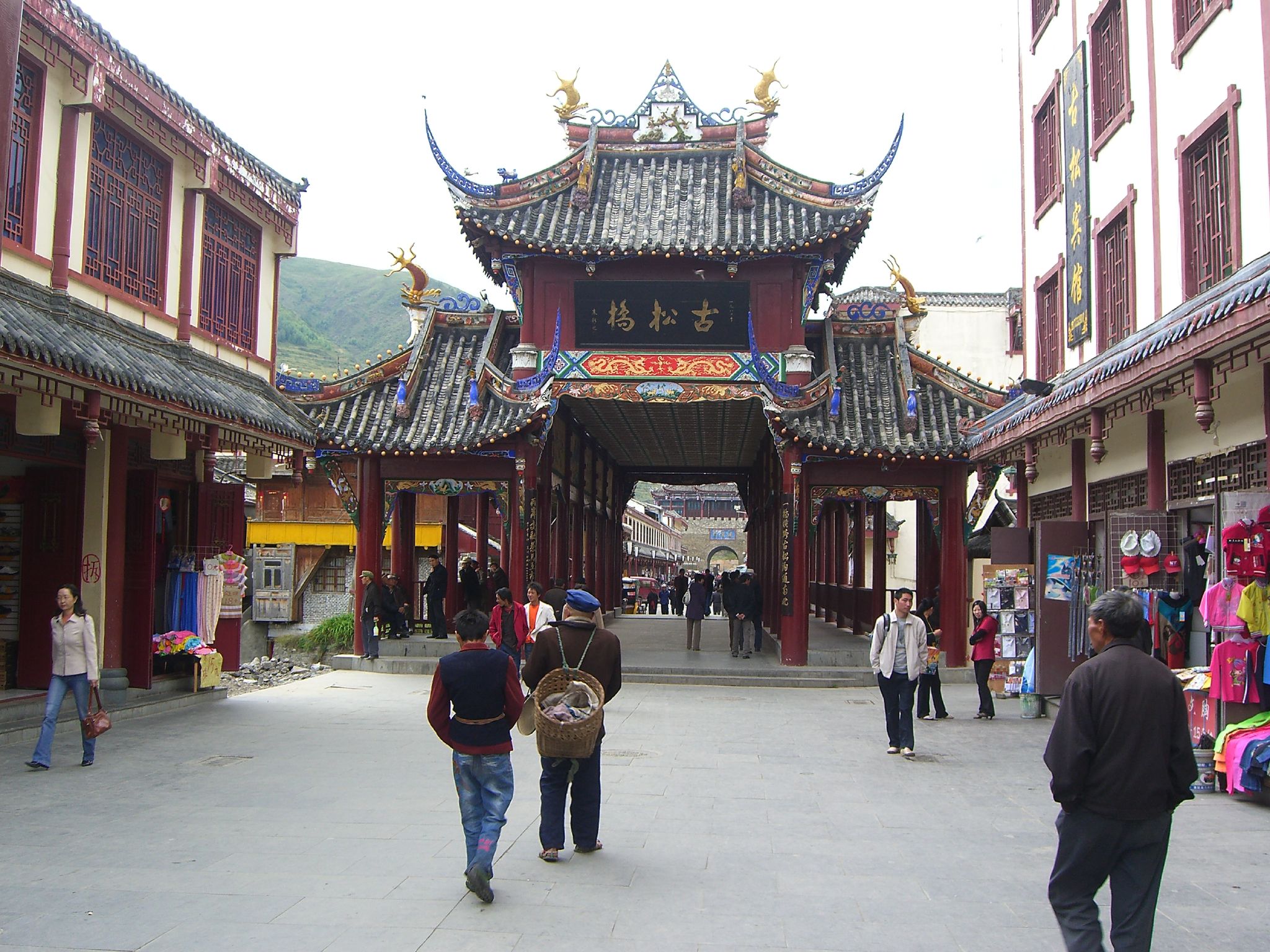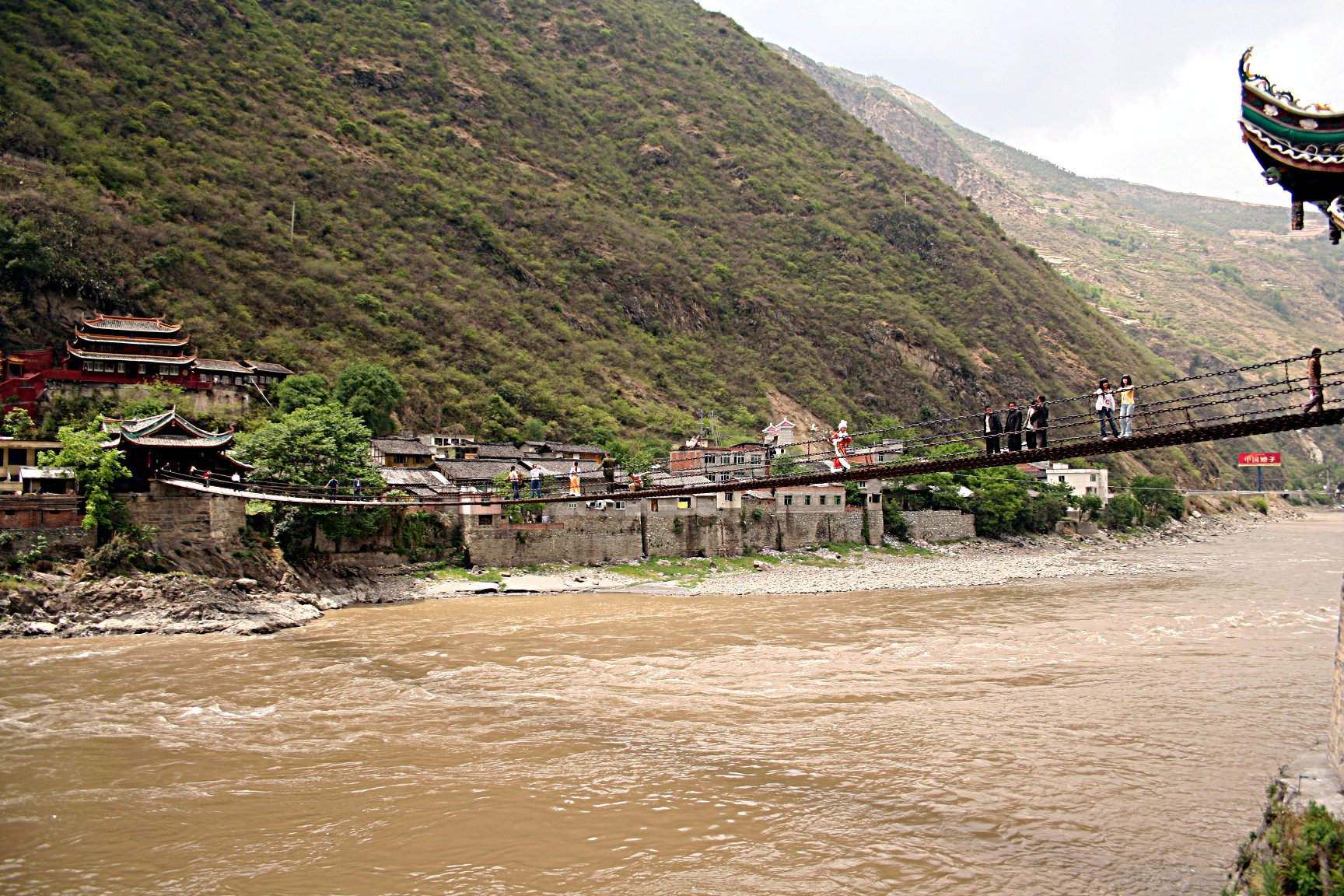|
Qionglai Mountains
Qionglai Mountains () is a mountain range in the Sichuan Province of China. It runs in the general north-south direction, and is located mostly within the Ngawa Tibetan and Qiang Autonomous Prefecture, in the north-central part of the province. Geography The Qionglai Range separates the basins of two major rivers of Sichuan: the Dadu River (to the west) and the Min River (to the east). Both rivers flow in the general southern direction, and are tributaries of the Yangtze. The highest point of the Qionglai Mountains is Mount Siguniang ( 四姑娘山, "Four Girls' Mountain"), 6250 m in elevation; it is located in the southern part of the range. Some of the Sichuan Giant Panda Sanctuaries - in particular, the Wolong Nature Reserve and the Mt. Siguniang Scenic Park () are located nearby. Ecology The characteristic ecosystem of the Qionglai Mountains and the Min Mountains (a smaller mountain range which is located to the northeast of the Qionglai, separated from it by the Min R ... [...More Info...] [...Related Items...] OR: [Wikipedia] [Google] [Baidu] |
Wenchuan County
Wenchuan County is a county in Ngawa Tibetan and Qiang Autonomous Prefecture, Sichuan, People's Republic of China. The county has an area of , and a population of 100,771 as of 2010. Wolong National Nature Reserve is a protected area located in Wenchuan County, which houses more than 150 highly endangered giant pandas. The Wolong Special Administrative Region is also located here. The county was the site of the epicentre and one of the areas most severely hit by the 2008 Sichuan earthquake, also known as the Wenchuan earthquake. Toponymy The county is named after the Wenshui River (), now known as the Min River. History Wenchuan County was established in 1958, when the former Maowen Qiang Autonomous County () was split into Mao County and Wenchuan County. Wenchuan earthquake On May 12, 2008, an earthquake with moment magnitude 7.9 hit the Sichuan Province, with epicentre located in the town of Yingxiu, in Wenchuan county. The county was therefore one of the areas most s ... [...More Info...] [...Related Items...] OR: [Wikipedia] [Google] [Baidu] |
Mount Siguniang
Mount Siguniang (; , ''Skubla'') is the highest mountain of Qionglai Mountains in Western China. It is located in the bordering area of Rilong Town, Xiaojin County and Wenchuan County in Ngawa Tibetan and Qiang Autonomous Prefecture, Sichuan Province. Mount Siguniang is renowned for its beauty. Mount Siguniang National Park was identified as a UNESCO Heritage Site as part of Sichuan Giant Panda Sanctuaries in 2006. The park comprises Mount Siguniang and the surrounding three valleys, namely Changping Valley (), Haizi Valley () and Shuangqiao Valley (), covering an area of 2,000sq km. Peaks Mount Siguniang encompasses four peaks (with meaning 'peak'): Daguniang Feng (Big Peak or 1st peak), Erguniang Feng (2nd peak), Sanguniang Feng (3rd peak), and Yaomei Feng, also known as Sanzuoshan Feng (3rd peak). The highest peak is (), also known as the "Queen of Sichuan's peaks" (), standing at . It is also the second highest mountain in Sichuan Province Sichuan (; zh, c=, ... [...More Info...] [...Related Items...] OR: [Wikipedia] [Google] [Baidu] |
Sichuan
Sichuan (; zh, c=, labels=no, ; zh, p=Sìchuān; alternatively romanized as Szechuan or Szechwan; formerly also referred to as "West China" or "Western China" by Protestant missions) is a province in Southwest China occupying most of the Sichuan Basin and the easternmost part of the Tibetan Plateau between the Jinsha River on the west, the Daba Mountains in the north and the Yungui Plateau to the south. Sichuan's capital city is Chengdu. The population of Sichuan stands at 83 million. Sichuan neighbors Qinghai to the northwest, Gansu to the north, Shaanxi to the northeast, Chongqing to the east, Guizhou to the southeast, Yunnan to the south, and the Tibet Autonomous Region to the west. In antiquity, Sichuan was the home of the ancient states of Ba and Shu. Their conquest by Qin strengthened it and paved the way for Qin Shi Huang's unification of China under the Qin dynasty. During the Three Kingdoms era, Liu Bei's state of Shu was based in Sichuan. The ... [...More Info...] [...Related Items...] OR: [Wikipedia] [Google] [Baidu] |
Aba Tibetan And Qiang Autonomous Prefecture
Ngawa Tibetan and Qiang Autonomous Prefecture, also known as Aba (; Qiang: ; ), is an autonomous prefecture of northwestern Sichuan, bordering Gansu to the north and northeast and Qinghai to the northwest. Its seat is in Barkam, and it has an area of . The population was 919,987 in late 2013. The county of Wenchuan in Ngawa is the site of the epicenter of the 2008 Sichuan earthquake, in which over 20,000 of its residents died and 40,000 were injured. History and names During the reign of Tibet's king Trisong Deutsen in the 8th century, the Gyalrong area was visited by the great translator Vairotsana. In 1410 Je Tsongkhapa's student Tshakho Ngawang Tapa established the first Tibetan Buddhist Gelug school monastery in the area, called "Gyalrong". In contemporary history, most of Ngawa was under the 16th Administrative Prefecture of Szechwan (), which was established by the Republic of China (ROC). The People's Republic of China defeated ROC troops in this area during Ch ... [...More Info...] [...Related Items...] OR: [Wikipedia] [Google] [Baidu] |
Ngawa Tibetan And Qiang Autonomous Prefecture
Ngawa Tibetan and Qiang Autonomous Prefecture, also known as Aba (; Qiang: ; ), is an autonomous prefecture of northwestern Sichuan, bordering Gansu to the north and northeast and Qinghai to the northwest. Its seat is in Barkam, and it has an area of . The population was 919,987 in late 2013. The county of Wenchuan in Ngawa is the site of the epicenter of the 2008 Sichuan earthquake, in which over 20,000 of its residents died and 40,000 were injured. History and names During the reign of Tibet's king Trisong Deutsen in the 8th century, the Gyalrong area was visited by the great translator Vairotsana. In 1410 Je Tsongkhapa's student Tshakho Ngawang Tapa established the first Tibetan Buddhist Gelug school monastery in the area, called "Gyalrong". In contemporary history, most of Ngawa was under the 16th Administrative Prefecture of Szechwan (), which was established by the Republic of China (ROC). The People's Republic of China defeated ROC troops in this area during Chinese ... [...More Info...] [...Related Items...] OR: [Wikipedia] [Google] [Baidu] |
Dadu River
The Dadu River (), known in Tibetan as the Gyelmo Ngul Chu, is a major river located primarily in Sichuan province, southwestern China. The Dadu flows from the eastern Tibetan Plateau into the Sichuan Basin where it joins with the Min River, a tributary of the Yangtze River. Measured from its geographic source, the Dadu is actually longer than the Min and thus forms the main stem of the Min River system. Shuangjiangkou Dam, expected to be the tallest dam in the world, is being built on the Dadu River. Geography Source The Dadu River originates, in name, in Danba and ends in Leshan where it meets the Min River. The true source of Dadu, and thus the entire Min River system, however, lies in Qinghai Province in the eastern Tibetan Plateau. In this region there are multiple headwaters of the Dadu with nearly identical lengths that have resulted in competing claims as the true source of the Dadu. In 2013, the China Academy of Sciences announced they had located the geographic ... [...More Info...] [...Related Items...] OR: [Wikipedia] [Google] [Baidu] |
Min River (Sichuan)
The Min River or Min Jiang () is a in central Sichuan province, China. It is a tributary of the upper Yangtze River which it joins at Yibin. Within China, it was traditionally taken as the main course of the upper Yangtze prior to extensive exploration of its sources. Geography The Min River flows in the general southern direction. It starts in north-central Sichuan, where its basin is limited by the Qionglai Mountains in the west and the Min Mountains in the east. The river passes through the Longmen Mountains and enters the plains of the Sichuan Basin near Dujiangyan. In that area, the ancient Irrigation System and the modern Zipingpu dam are located. The Giant Buddha of Leshan is built into the stone banks of the Min river. Names Some 19th-century Western authors used the name Blue River as the "colloquial name" for the Minjiang, after the former local Chinese name ''Qingshui'' (, lit. "Clear water"), and the belief that the Min constituted the main course of the Yang ... [...More Info...] [...Related Items...] OR: [Wikipedia] [Google] [Baidu] |
Yangtze
The Yangtze or Yangzi ( or ; ) is the longest river in Asia, the third-longest in the world, and the longest in the world to flow entirely within one country. It rises at Jari Hill in the Tanggula Mountains (Tibetan Plateau) and flows in a generally easterly direction to the East China Sea. It is the seventh-largest river by discharge volume in the world. Its drainage basin comprises one-fifth of the land area of China, and is home to nearly one-third of the country's population. The Yangtze has played a major role in the history, culture, and economy of China. For thousands of years, the river has been used for water, irrigation, sanitation, transportation, industry, boundary-marking, and war. The prosperous Yangtze Delta generates as much as 20% of historical GDP of China, China's GDP. The Three Gorges Dam on the Yangtze is the list of the largest hydroelectric power stations, largest hydro-electric power station in the world that is in use. In mid-2014, the Chine ... [...More Info...] [...Related Items...] OR: [Wikipedia] [Google] [Baidu] |
Sichuan Giant Panda Sanctuaries
The Sichuan Giant Panda Sanctuaries () located in southwest Sichuan province of China, is the home to more than 30% of the world's giant pandas and is among the most important sites for the captive breeding of these pandas. It covers 9245 km2 with seven nature reserves and nine scenic parks in the Qionglai and Jiajin Mountains. Along with the giant panda, the sanctuary is a refuge to other endangered species such as the red panda, the snow leopard, and the clouded leopard. Outside of the tropical rainforests, it is among the botanically richest sites of the world, and is home to between 5,000 and 6,000 species of flora. It has been noted that the region is similar to the paleo-tropic forests of the Paleogene and Neogene Periods. Because of its biodiversity and conservation of giant pandas, these sanctuaries were listed as UNESCO World Heritage Sites A World Heritage Site is a landmark or area with legal protection by an international convention administered by the Unite ... [...More Info...] [...Related Items...] OR: [Wikipedia] [Google] [Baidu] |
Wolong Nature Reserve
Wolong National Nature Reserve (), also known as Wolong Special Administrative Region (), is a protected area located in Wenchuan County, Sichuan Province, People's Republic of China. Established in 1963 with an initial size of about 20,000 hectares, the reserve was further expanded in 1975, covering an area of about 200,000 hectares in the Qionglai Mountains region. There are over 4,000 different species recorded in the reserve. According to China's Third National Giant Panda Survey, Wolong National Nature Reserve houses about 150 wild giant pandas. The reserve is also a home to many other endangered species including: snow leopards, red pandas, golden monkeys, white-lipped deer and many precious plants. Before the devastating 2008 Wenchuan earthquake Wolong received up to 200,000 visitors every year. As one of the Sichuan Giant Panda Sanctuaries, Wolong National Nature Reserve has been a UNESCO World Heritage Site since 2006. Background In June 1980, the Chinese government s ... [...More Info...] [...Related Items...] OR: [Wikipedia] [Google] [Baidu] |






